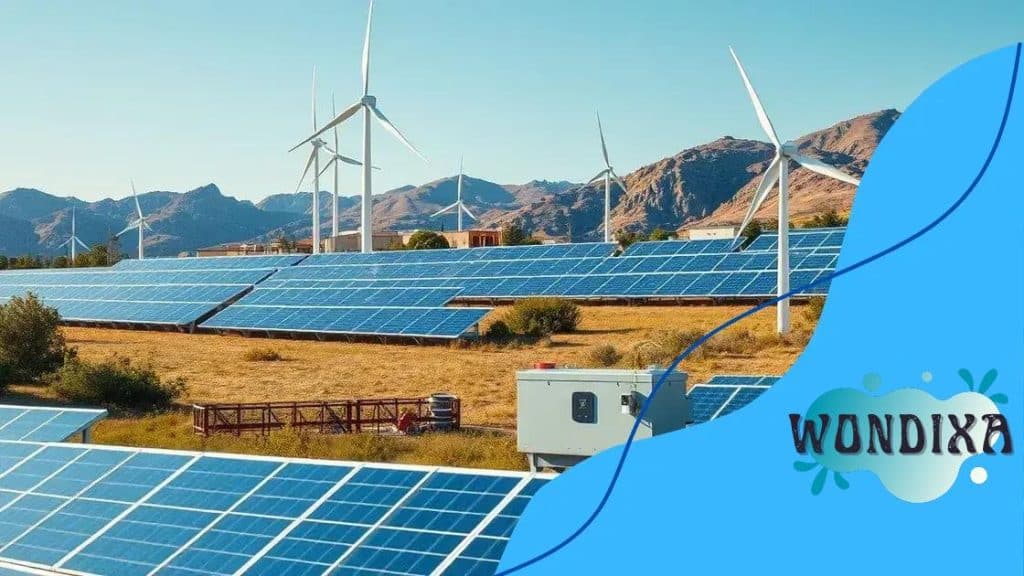Advances in renewable energy storage: what you need to know

Advances in renewable energy storage utilize technologies like solid-state batteries and smart grids to enhance efficiency, reduce costs, and support the integration of solar and wind energy into the power grid.
Advances in renewable energy storage are transforming how we harness and use clean energy. Have you ever wondered how effective storage can drive the green transition? Let’s dive into the latest innovations and their potential impact.
Understanding renewable energy storage technologies
Understanding renewable energy storage technologies is critical for advancing our clean energy future. As we rely more on sources like solar and wind, we need effective methods to store the energy they produce.
Key Technologies in Energy Storage
There are several technologies making waves in the energy storage sector today. These include:
- Batteries: Lithium-ion batteries are the most common. They are used in everything from electric cars to home energy systems.
- Pumped Hydro Storage: This method uses gravity. Water is pumped to a higher elevation and released back down to generate electricity when needed.
- Flywheels: These devices store energy in the form of rotational motion. They can quickly release energy for short bursts, making them ideal for stabilizing grids.
The combination and enhancement of these technologies can improve energy efficiency, which is crucial for our energy transition. Innovations in energy storage are helping to solve challenges like energy supply during peak demand times. For instance, when the sun isn’t shining or the wind isn’t blowing, these technologies ensure that we still have energy available.
Challenges of Current Technologies
Despite their promise, renewable energy storage technologies face several challenges. For example, battery recycling and disposal is a pressing issue. Creating efficient systems that do not harm the environment is vital.
There is also the need for development in long-term storage options. Current technologies excel in short-term energy bursts but lack the capacity for long-term storage. Exploring new materials and designs can lead to solutions for these issues.
As we continue to explore ways to utilize these technologies, it’s essential to understand their functionality and limitations. This understanding will guide the ongoing research and investments necessary for advancing our energy systems.
The role of batteries in energy storage
The role of batteries in energy storage is crucial as we shift toward renewable energy sources. These devices enable us to store energy produced from solar panels and wind turbines for later use.
How Batteries Work
Batteries store electrical energy through chemical reactions. When energy is needed, these reactions release the stored energy back into the system. This makes batteries versatile and essential for various applications, including:
- Grid Storage: Batteries help balance supply and demand on electrical grids.
- Electric Vehicles: They power electric cars, providing a cleaner alternative to fossil fuels.
- Home Energy Systems: Homeowners use batteries to store solar energy, reducing reliance on the grid.
As more people embrace renewable energy, the demand for battery technology grows. Companies are investing in research to create batteries that are more efficient, longer-lasting, and environmentally friendly. Innovations like lithium-sulfur and solid-state batteries show great promise. These new types aim to improve energy density, meaning they can store more energy in a smaller space.
Challenges Facing Battery Technologies
Unlike traditional energy sources, the effectiveness of batteries can be affected by temperature and usage patterns. Temperature fluctuations can lead to reduced performance. Furthermore, as the demand for batteries increases, so does the need for sustainable materials. Many battery components come from rare minerals that can have negative environmental impacts.
To tackle these challenges, researchers are exploring ways to recycle batteries effectively. Recycling would reduce waste and lessen the need for new materials. This is an essential step towards making batteries a sustainable choice for the future, as they play a vital role in the global energy transition.
Innovations in solar energy storage solutions

Innovations in solar energy storage solutions are essential for maximizing the potential of solar power. Efficient storage allows us to harness energy during sunny days and use it when the sun isn’t shining.
Emerging Technologies
Several new technologies are making waves in solar energy storage. These advancements improve efficiency and reduce costs:
- Solid-State Batteries: Unlike traditional lithium-ion batteries, solid-state batteries use a solid electrolyte. This change enhances safety and energy density.
- Flow Batteries: Flow batteries store energy in liquid electrolytes, making them ideal for large-scale applications.
- Thermal Storage: This method uses mediums like molten salt to store solar energy as heat for later use, especially in power plants.
These technologies not only increase the efficiency of solar energy systems, but they also make renewable resources more reliable. As solar energy becomes a larger part of our electricity mix, these innovations help stabilize our power supply.
Improving Efficiency
With innovations, the aim is to create systems that can store more energy with less space. Research is focusing on materials that can improve battery life and efficiency. For example, incorporating advanced materials, like silicon in battery anodes, shows improved performance.
Innovations in energy management systems also play a role. Smart technology can optimize when to store energy and when to use it, enhancing the overall effectiveness of solar energy storage solutions.
Moreover, partnerships between tech companies and renewable energy providers are driving forward these innovations. By collaborating, they can develop integrated systems that provide reliable energy storage for homes and businesses alike.
Challenges facing renewable energy storage development
Challenges facing renewable energy storage development are significant as we push for cleaner energy solutions. Understanding these hurdles is essential for advancing technology and creating a sustainable future.
Technical Limitations
Many storage technologies have limitations that hinder their effectiveness. For example, traditional batteries may not last long enough to meet high demand during peak usage times. Additionally, some systems require more space than is available, making large-scale implementation difficult.
- Energy Density: Many batteries have low energy density, which means they store less energy per unit of weight or volume.
- Cycle Life: The number of charge-discharge cycles before a battery’s performance declines is crucial for long-term use.
- Scalability: Some technologies cannot easily be scaled up for large applications, limiting their usefulness.
As we seek to improve these technologies, researchers are focused on finding solutions to enhance performance while lowering costs. Innovations in materials and design are key factors in overcoming these technical challenges.
Environmental Concerns
Another critical concern is the environmental impact of materials used in storage technologies. Many batteries rely on rare minerals like lithium and cobalt, which can be damaging to extract.
Moreover, the disposal of batteries poses additional risks. Without proper recycling systems, batteries can lead to contamination and waste problems. To address these issues, companies are exploring alternative materials and sustainability practices.
Developing methods for recycling batteries effectively can greatly reduce environmental risks. Emphasizing the use of abundant and less harmful materials can also support the wider adoption of renewable energy storage solutions.
Future trends in renewable energy storage
Future trends in renewable energy storage promise to reshape how we use and manage energy. As technology evolves, new innovations emerge that address existing challenges and enhance efficiency.
Advancements in Battery Technology
One significant trend is the development of advanced battery technologies. Researchers are exploring options like solid-state batteries, which could offer greater energy density and safety compared to traditional lithium-ion batteries.
- Silicon Anodes: Using silicon instead of graphite can increase battery capacity significantly.
- Recycling Innovations: New methods are being developed to recycle old batteries, minimizing waste and environmental impact.
- Cost Reduction: With mass production, the cost of battery technologies is expected to decrease, making renewable storage more accessible for everyone.
These advancements will not only extend battery life but also improve the economic viability of using renewable energy.
Integration with Smart Grids
Another key trend is the integration of renewable energy storage solutions with smart grids. Smart grids use digital technology to monitor and manage energy flow more efficiently. By connecting storage systems to smart grids, homeowners and businesses can better control their energy use.
This integration allows for dynamic energy management. When energy demand peaks, stored energy can be released to balance the grid, reducing the risk of blackouts.
As a result, consumers will have more control over their energy consumption and costs. This trend towards smarter energy systems is critical in supporting widespread adoption of renewable energy storage.
Furthermore, new business models are emerging. Companies are exploring virtual power plants, which aggregate distributed energy resources, including storage systems, to provide energy to the grid. This model promotes cooperation among users and maximizes the utilization of available resources.
FAQ – Frequently Asked Questions about Renewable Energy Storage
What are the main challenges in renewable energy storage development?
The main challenges include technical limitations of current technologies, environmental concerns regarding material sourcing, and the need for efficient recycling methods.
How do advancements in battery technology impact renewable energy storage?
Advancements such as solid-state batteries and innovative recycling methods enhance energy density, safety, and sustainability, making renewable energy storage more efficient.
What role do smart grids play in renewable energy management?
Smart grids optimize energy distribution and consumption by integrating renewable energy sources and storage systems, helping to balance supply and demand effectively.
How can consumers benefit from future trends in renewable energy storage?
Consumers can expect reduced costs, greater reliability, and more control over their energy use as technologies and business models evolve in renewable energy storage.





